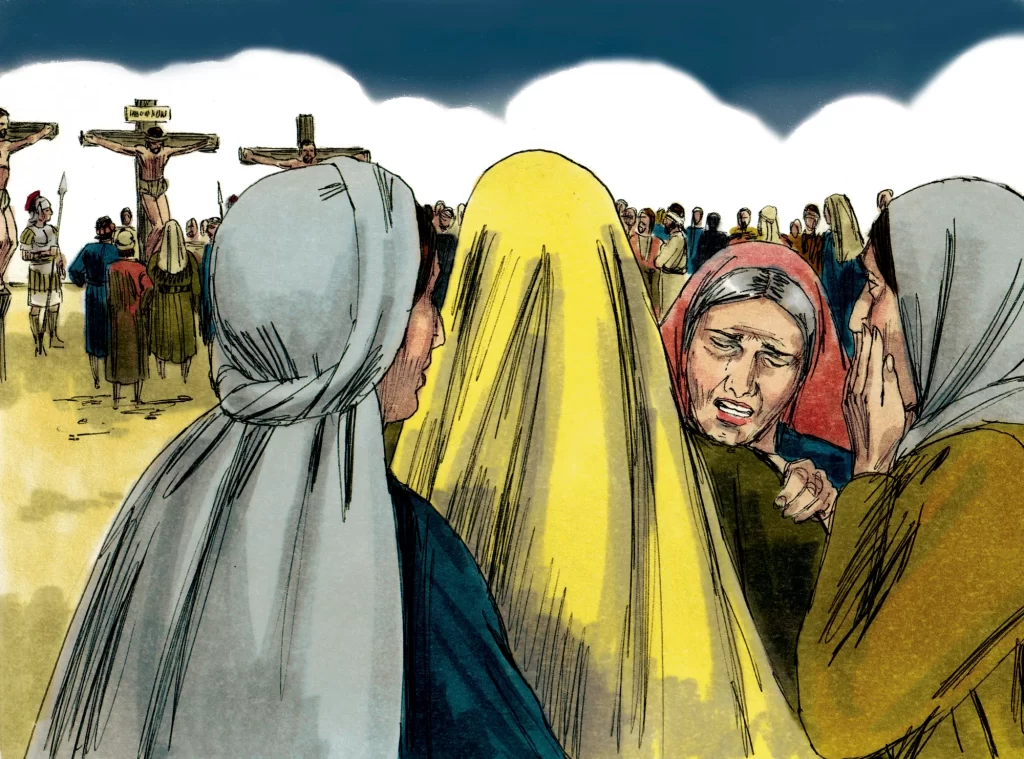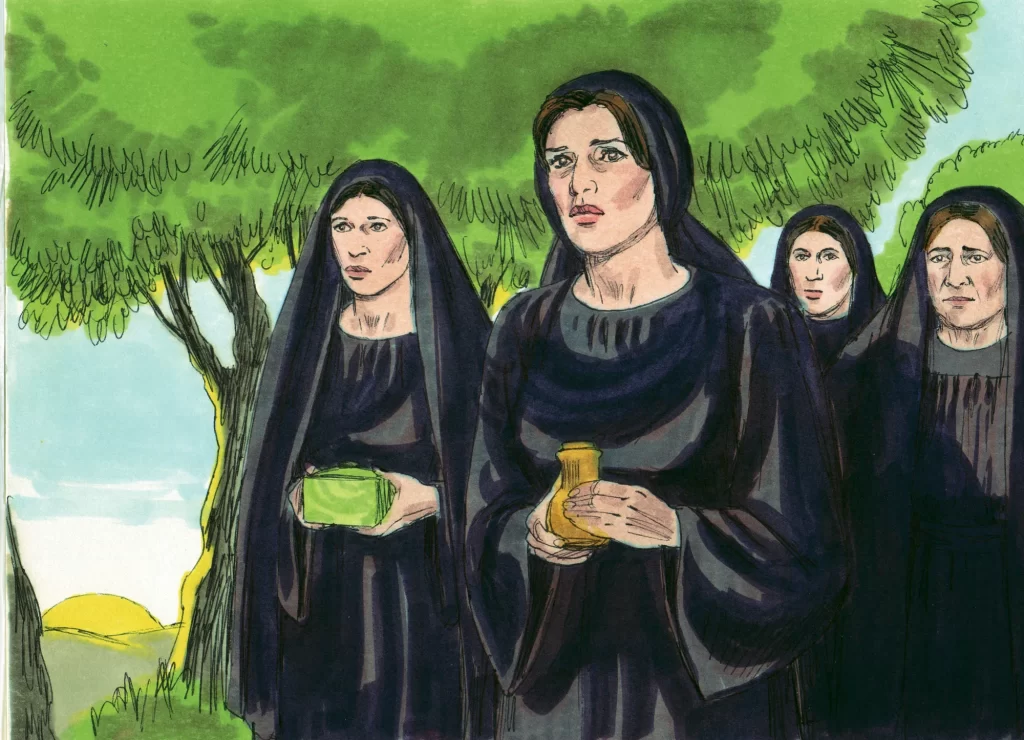Matthew 27 – 28; Mark 15 – 16; Luke 8:1-3, 23 – 24; and John 19-20
“After Jesus rose from the dead early on Sunday morning, the first person who saw him was Mary Magdalene, the woman from whom he had cast out seven demons,” Mark 16:9, NLT
Mary Magdalene watched, speechless while gut-wrenching agony engulfed Jesus as He hung on the cross amid shouts of abuse, mockery, challenges, and obscenities. This brutal form of execution involved binding His hands and feet and nailing them to the wooden cross.
Though she was taking it all in a distance away, her body shook under the power of an earthquake that crumbled the ground around the three crosses on Golgotha’s hill. Total darkness descended from heaven.
At 3 p.m. Friday, Jesus called out, “My God, My god, why have you abandoned me?” Despite the excruciating pain, He denied an offer of sour wine dripping from a sponge.
Jesus shouted again, then “released his spirit.” Died.
An arm’s length away from Mary Magdalene stood the mother of James and Joseph who swayed in anguish. The mother of James and John openly wept. Behind them, a short distance back were many other women who had come from Galilee with Jesus to care for him.
“This man truly was the Son of God!” Mary Magdalene heard a terrified Roman officer, and other soldiers declare in regretful gasps.
She whispered indignantly to herself: “Of course He is the son of God. I am a living witness.”
Mary Magdalene’s mind immediately took flight, away from the horrific scene.

As a Jewish woman from the fishing town Magdala, Jerusalem on the western shore of the Sea of Galilee, her childhood, teen years, and young adult days were dominated by the pain and embarrassment of severe emotional and psychological trauma. Seven demons attacked her every hour of every day, slowly stealing her dignity, killing her self-esteem, and destroying her self-worth.
Beauty and wealth did not protect her from the evil that assailed her body and mind. Instead, she was battered and bruised, injured and in agony from the demon possession.
Jesus changed all that. She remembers the moment. When Jesus looked at her, He immediately understood her state of desperation. She saw herself in His eyes, not as she was crouched at his feet, but as who she really was. Jesus commanded the demons to leave her body. They obeyed. Finally, she was whole, sane again. Her past finally didn’t matter because He had set her FREE from her past mistakes and sin.
In these ancient times, women in Jewish society did not typically carry important roles. But after her healing, Mary Magdalene became one of Jesus’ most celebrated disciples in a ministry already thought to be so radical the Pharisees were determined to demolish it. She was driven by gratitude. Jesus, on the other hand, ignored the cultural norms of the day with its patriarchal tendencies. Refusing to reduce women to their sexuality, Jesus treated them as people with worth, dignity.
“After this, Jesus traveled about from one town and village to another, proclaiming the good news of the kingdom of God. The Twelve were with him,and also some women who had been cured of evil spirits and diseases: Mary (called Magdalene) from whom seven demons had come out; Joanna the wife of Chuza, the manager of Herod’s household; Susanna; and many others. These women were helping to support them out of their own means. Luke 8: 1-3 NIV
The good days had turned into a nightmare. Here at Jesus’ crucifixion many disciples had fled. Only the women watched because they were less likely to be arrested.
Watching Jesus die on the cross, Mary Magdalene wondered to herself, “Did Jesus heal me only so I can be left alone, friendless again?”
That thought dissolved into the promises of a resurrection that permeated the back of her mind, safe from doubt. Besides, she needed to carefully watch all the activity surrounding Jesus because she needed to know the exact location where Jesus was laid to rest.
Mary Magdalene refused to let grief paralyze her movements and thoughts. She spurned feelings of hopelessness. Work needed to get done. So, early Sunday morning she set out in the dark with a few other women to anoint Jesus’ body in the new tomb secured by Joseph of Arimathea and Nicodemus.

When they reached the site and saw the stone rolled away, all the things Jesus had taught her and the other disciples about his resurrection apparently left her memory. Instead of joy and jubilation, Mary Magdalene was filled with doubt and fear, leaning more towards a conspiracy theory. She ran and told Simon Peter and John: “They have taken the Lord’s body out of the tomb, and we don’t know where they have put him!”
The two disciples ran to the tomb to check out her story. Jewish rabbinical law would not allow a woman’s testimony in court. Peter and John merely accepted the notion that women were gullible, naïve, and even hysterical by nature.
When they saw that Mary Magdalene had told the truth, they went home puzzled about what happened. A grave robber couldn’t have stolen Jesus’s body, they thought. One reason was the linen wrappings they saw in the tomb looked like an empty cocoon from which Jesus had emerged.
Slowly they began to remember Jesus’ teachings that He would die, but he would also rise again!
Meanwhile, Mary Magdalene walked back to the tomb and sobbed. She was determined to learn the truth. So, for the last time, she stooped and looked inside the cave. To her amazement, two angels in white robes were inside, one sitting at the head and the other at the foot of the place where Jesus’ body had been lying.
“Dear woman, why are you cry?” the angels asked her.
Though afraid, Mary Magdalene spoke up: “Because they have taken away my Lord, and I don’t know where they have put him.”
The Message Bible ends the story this way: (John 20: 14-18)
“After she said this, she turned away and saw Jesus standing there. But she didn’t recognize him.
Jesus spoke to her, “Woman, why do you weep? Who are you looking for?”
She, thinking that he was the gardener, said, “Sir, if you took him, tell me where you put him so I can care for him.”
Jesus said, “Mary.” He called her by name!
Turning to face him, she said in Hebrew, “Rabboni!” meaning “Teacher!”
Jesus said, “Don’t cling to me, for I have not yet ascended to the Father. Go to my brothers and tell them, ‘I ascend to my Father and your Father, my God and your God.’”
Mary Magdalene went, telling the news to the disciples: “I saw the Master!” And she told them everything he said to her.
Mary Magdalene was with Jesus at the Crucifixion, present at the tomb, the first person to whom Jesus appeared after his resurrection and the first to preach the “Good News” of that miracle.
St. Thomas Aquinas described her as “an apostle to the apostles.”
Sources:
Bucher, Meg, “Who was Mary Magdalene in the Bible?” Bible Study Tools. April 1, 2024. Salem Web Network. https://www.biblestudytools.com/bible-study/topical-studies/who-was-mary-magdalene.html
Carroll, James. “Who was Mary Magdalene?” Smithsonian Magazine. June 2006. https://www.smithsonianmag.com/history/who-was-mary-magdalene-119565482/
Heeren, Jennifer. “Lessons We Can Learn from Mary Magdalene’s Faithful Life.” Crosswalk.com. Feb. 15, 2024. https://www.crosswalk.com/faith/bible-study/lessons-we-can-learn-from-mary-magdalenes-faithful-life.html
Johnson, Rev. Katurah Worrill. “Mary Magdalene: Setting Her Reputation Straight.” Women of the Bible for Women of Color. Urban Spirit, LLC. 2021. P 160-161.
Mary Magdalene Biography, A&E; Television Networks. April 2, 2014. https://www.biography.com/religious-figures/mary-magdalene
Schrader, Elizabeth, “Mary or Martha?: A Duke Scholar’s Research finds Mary Magdalene downplayed by New Testament scribes. Duke Today. June 18, 2019.
Thornton, Angie Velasquez. Mary Magdalene: From Tormented Demoniac to Faithful Disciple. Bible & Theology. July 23, 2023. https://ca.thegospelcoalition.org/article/mary-magdalene-from-tormented-demoniac-to-faithful-disciple/
Weems, Renita J. Just a Sister Away: A Womanist Vision of Women’s Relationships in the Bible. Innis Free Press, Inc. 1988.




5 thoughts on “Mary Magdalene: a wounded woman healed by Jesus, prompted to lead His entourage of women”
You have noted very interesting details ! ps nice site.
Yay google is my king assisted me to find this outstanding internet site! .
I conceive this internet site holds very fantastic indited subject matter articles.
I am usually to blogging and i really appreciate your content. The article has really peaks my interest. I’m going to bookmark your web site and keep checking for brand spanking new information.
Hello.This post was extremely fascinating, especially because I was looking for thoughts on this subject last Friday.